Lu Ma
Not All Tokens and Heads Are Equally Important: Dual-Level Attention Intervention for Hallucination Mitigation
Jun 14, 2025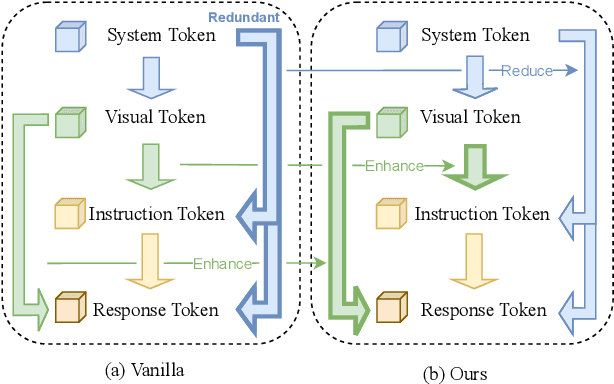

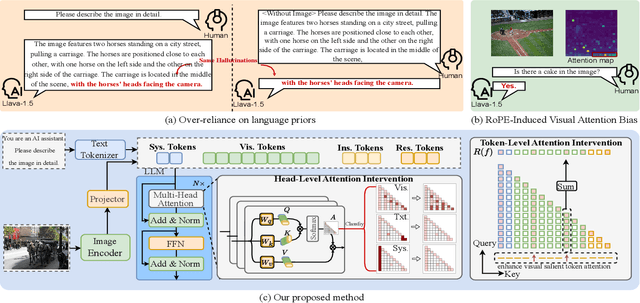

Abstract:Large vision-language models (LVLMs) have shown remarkable capabilities across a wide range of multimodal tasks. However, they remain prone to visual hallucination (VH), often producing confident but incorrect descriptions of visual content. We present VisFlow, an efficient and training-free framework designed to mitigate VH by directly manipulating attention patterns during inference. Through systematic analysis, we identify three key pathological attention behaviors in LVLMs: (1) weak visual grounding, where attention to visual tokens is insufficient or misallocated, over-focusing on uninformative regions; (2) language prior dominance, where excessive attention to prior response tokens reinforces autoregressive patterns and impairs multimodal alignment; (3) prompt redundancy, where many attention heads fixate on system prompt tokens, disrupting the integration of image, instruction, and response content. To address these issues, we introduce two inference-time interventions: token-level attention intervention (TAI), which enhances focus on salient visual content, and head-level attention intervention (HAI), which suppresses over-attention to prompt and nearby text tokens. VisFlow operates without additional training or model modifications. Extensive experiments across models and benchmarks show that VisFlow effectively reduces hallucinations and improves visual factuality, with negligible computational cost.
Spectra-to-Structure and Structure-to-Spectra Inference Across the Periodic Table
Jun 13, 2025Abstract:X-ray Absorption Spectroscopy (XAS) is a powerful technique for probing local atomic environments, yet its interpretation remains limited by the need for expert-driven analysis, computationally expensive simulations, and element-specific heuristics. Recent advances in machine learning have shown promise for accelerating XAS interpretation, but many existing models are narrowly focused on specific elements, edge types, or spectral regimes. In this work, we present XAStruct, a learning framework capable of both predicting XAS spectra from crystal structures and inferring local structural descriptors from XAS input. XAStruct is trained on a large-scale dataset spanning over 70 elements across the periodic table, enabling generalization to a wide variety of chemistries and bonding environments. The model includes the first machine learning approach for predicting neighbor atom types directly from XAS spectra, as well as a unified regression model for mean nearest-neighbor distance that requires no element-specific tuning. While we explored integrating the two pipelines into a single end-to-end model, empirical results showed performance degradation. As a result, the two tasks were trained independently to ensure optimal accuracy and task-specific performance. By combining deep neural networks for complex structure-property mappings with efficient baseline models for simpler tasks, XAStruct offers a scalable and extensible solution for data-driven XAS analysis and local structure inference. The source code will be released upon paper acceptance.
Learning What Reinforcement Learning Can't: Interleaved Online Fine-Tuning for Hardest Questions
Jun 09, 2025
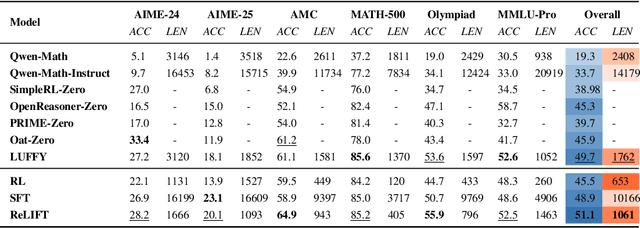
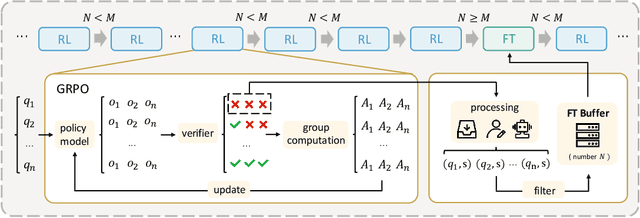

Abstract:Recent advances in large language model (LLM) reasoning have shown that sophisticated behaviors such as planning and self-reflection can emerge through reinforcement learning (RL). However, despite these successes, RL in its current form remains insufficient to induce capabilities that exceed the limitations of the base model, as it is primarily optimized based on existing knowledge of the model rather than facilitating the acquisition of new information. To address this limitation, we employ supervised fine-tuning (SFT) to learn what RL cannot, which enables the incorporation of new knowledge and reasoning patterns by leveraging high-quality demonstration data. We analyze the training dynamics of RL and SFT for LLM reasoning and find that RL excels at maintaining and improving performance on questions within the model's original capabilities, while SFT is more effective at enabling progress on questions beyond the current scope of the model. Motivated by the complementary strengths of RL and SFT, we introduce a novel training approach, \textbf{ReLIFT} (\textbf{Re}inforcement \textbf{L}earning \textbf{I}nterleaved with Online \textbf{F}ine-\textbf{T}uning). In ReLIFT, the model is primarily trained using RL, but when it encounters challenging questions, high-quality solutions are collected for fine-tuning, and the training process alternates between RL and fine-tuning to enhance the model's reasoning abilities. ReLIFT achieves an average improvement of over +5.2 points across five competition-level benchmarks and one out-of-distribution benchmark compared to other zero-RL models. Furthermore, we demonstrate that ReLIFT outperforms both RL and SFT while using only 13\% of the detailed demonstration data, highlighting its scalability. These results provide compelling evidence that ReLIFT overcomes the fundamental limitations of RL and underscores the significant potential.
An adaptive filter bank based neural network approach for time delay estimation and speech enhancement
Feb 10, 2025



Abstract:Time delay estimation (TDE) plays a key role in acoustic echo cancellation (AEC) using adaptive filter method. Considerable residual echo will be left if estimation error arises. Here, in this paper, we proposed an adaptive filter bank based neural network approach where the delay is estimated by a bank of adaptive filters with overlapped time scope, and all the energy of filter weights are concatenated and feed to a classification network. The index with maximal probability is chosen as the estimated delay. Based on this TDE, an AEC scheme is designed using a neural network for residual echo and noise suppression, and the optimally-modified log-spectral amplitude (OMLSA) algorithm is adopted to make it robust. Also, a robust automatic gain control (AGC) scheme with spectrum smoothing method is designed to amplify speech segments. Performance evaluations reveal that higher performance can be achieved for our scheme.
Acceleration Algorithms in GNNs: A Survey
May 07, 2024


Abstract:Graph Neural Networks (GNNs) have demonstrated effectiveness in various graph-based tasks. However, their inefficiency in training and inference presents challenges for scaling up to real-world and large-scale graph applications. To address the critical challenges, a range of algorithms have been proposed to accelerate training and inference of GNNs, attracting increasing attention from the research community. In this paper, we present a systematic review of acceleration algorithms in GNNs, which can be categorized into three main topics based on their purpose: training acceleration, inference acceleration, and execution acceleration. Specifically, we summarize and categorize the existing approaches for each main topic, and provide detailed characterizations of the approaches within each category. Additionally, we review several libraries related to acceleration algorithms in GNNs and discuss our Scalable Graph Learning (SGL) library. Finally, we propose promising directions for future research. A complete summary is presented in our GitHub repository: https://github.com/PKU-DAIR/SGL/blob/main/Awsome-GNN-Acceleration.md.
Vector Approximate Message Passing based Channel Estimation for MIMO-OFDM Underwater Acoustic Communications
Nov 22, 2022



Abstract:Accurate channel estimation is critical to the performance of orthogonal frequency-division multiplexing (OFDM) underwater acoustic (UWA) communications, especially under multiple-input multiple-output (MIMO) scenarios. In this paper, we explore Vector Approximate Message Passing (VAMP) coupled with Expected Maximum (EM) to obtain channel estimation (CE) for MIMO OFDM UWA communications. The EM-VAMP-CE scheme is developed by employing a Bernoulli-Gaussian (BG) prior distribution for the channel impulse response, and hyperparameters of the BG prior distribution are learned via the EM algorithm. Performance of the EM-VAMP-CE is evaluated through both synthesized data and real data collected in two at-sea UWA communication experiments. It is shown the EM-VAMP-CE achieves better performance-complexity tradeoff compared with existing channel estimation methods.
Multi-Scale Attention Neural Network for Acoustic Echo Cancellation
May 31, 2021



Abstract:Acoustic Echo Cancellation (AEC) plays a key role in speech interaction by suppressing the echo received at microphone introduced by acoustic reverberations from loudspeakers. Since the performance of linear adaptive filter (AF) would degrade severely due to nonlinear distortions, background noises, and microphone clipping in real scenarios, deep learning has been employed for AEC for its good nonlinear modelling ability. In this paper, we constructed an end-to-end multi-scale attention neural network for AEC. Temporal convolution is first used to transform waveform into spectrogram. The spectrograms of the far-end reference and the near-end mixture are concatenated, and fed to a temporal convolution network (TCN) with stacked dilated convolution layers. Attention mechanism is performed among these representations from different layers to adaptively extract relevant features by referring to the previous hidden state in the encoder long short-term memory (LSTM) unit. The representations are weighted averaged and fed to the encoder LSTM for the near-end speech estimation. Experiments show the superiority of our method in terms of the echo return loss enhancement (ERLE) for single-talk periods and the perceptual evaluation of speech quality (PESQ) score for double-talk periods in background noise and nonlinear distortion scenarios.
Noise Classification Aided Attention-Based Neural Network for Monaural Speech Enhancement
May 31, 2021



Abstract:This paper proposes an noise type classification aided attention-based neural network approach for monaural speech enhancement. The network is constructed based on a previous work by introducing a noise classification subnetwork into the structure and taking the classification embedding into the attention mechanism for guiding the network to make better feature extraction. Specifically, to make the network an end-to-end way, an audio encoder and decoder constructed by temporal convolution is used to make transformation between waveform and spectrogram. Additionally, our model is composed of two long short term memory (LSTM) based encoders, two attention mechanism, a noise classifier and a speech mask generator. Experiments show that, compared with OM-LSA and the previous work, the proposed noise classification aided attention-based approach can achieve better performance in terms of speech quality (PESQ). More promisingly, our approach has better generalization ability to unseen noise conditions.
Multi-Scale Temporal Convolution Network for Classroom Voice Detection
May 31, 2021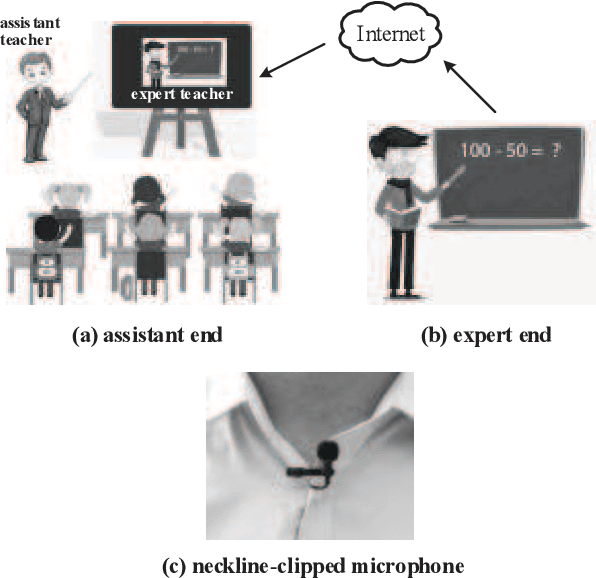
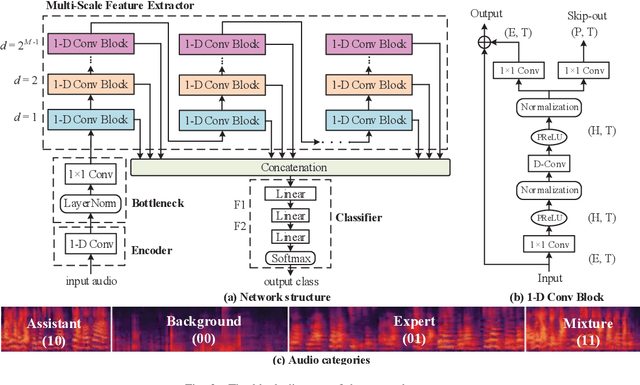
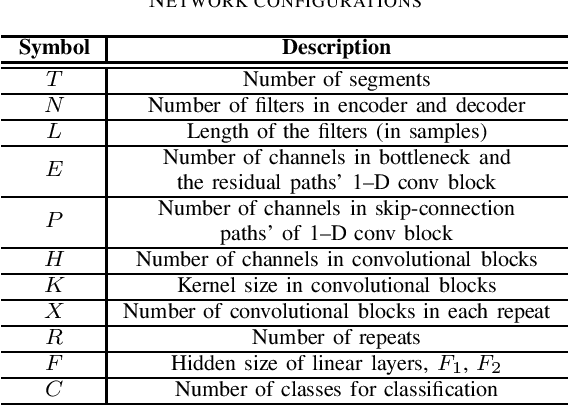
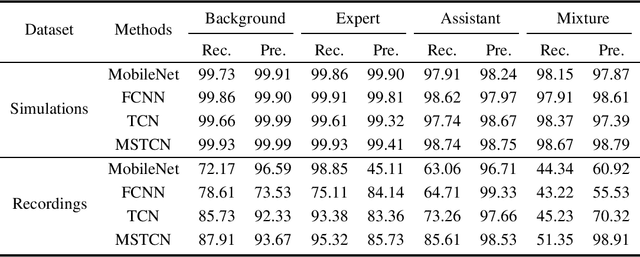
Abstract:Teaching with the cooperation of expert teacher and assistant teacher, which is the so-called "double-teachers classroom", i.e., the course is giving by the expert online and presented through projection screen at the classroom, and the teacher at the classroom performs as an assistant for guiding the students in learning, is becoming more prevalent in today's teaching method for K-12 education. For monitoring the teaching quality, a microphone clipped on the assistant's neckline is always used for voice recording, then fed to the downstream tasks of automatic speech recognition (ASR) and neural language processing (NLP). However, besides its voice, there would be some other interfering voices, including the expert's one and the student's one. Here, we propose to extract the assistant' voices from the perspective of sound event detection, i.e., the voices are classified into four categories, namely the expert, the teacher, the mixture of them, and the background. To make frame-level identification, which is important for grabbing sensitive words for the downstream tasks, a multi-scale temporal convolution neural network is constructed with stacked dilated convolutions for considering both local and global properties. These features are concatenated and fed to a classification network constructed by three linear layers. The framework is evaluated on simulated data and real-world recordings, giving considerable performance in terms of precision and recall, compared with some classical classification methods.
EchoFilter: End-to-End Neural Network for Acoustic Echo Cancellation
May 31, 2021
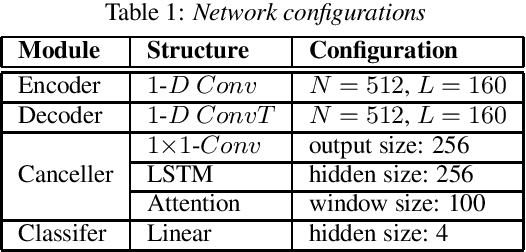
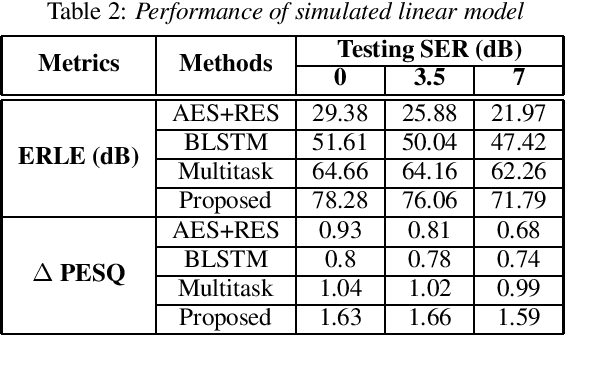

Abstract:Acoustic Echo Cancellation (AEC) whose aim is to suppress the echo originated from acoustic coupling between loudspeakers and microphones, plays a key role in voice interaction. Linear adaptive filter (AF) is always used for handling this problem. However, since there would be some severe effects in real scenarios, such nonlinear distortions, background noises, and microphone clipping, it would lead to considerable residual echo, giving poor performance in practice. In this paper, we propose an end-to-end network structure for echo cancellation, which is directly done on time-domain audio waveform. It is transformed to deep representation by temporal convolution, and modelled by Long Short-Term Memory (LSTM) for considering temporal property. Since time delay and severe reverberation may exist at the near-end with respect to the far-end, a local attention is employed for alignment. The network is trained using multitask learning by employing an auxiliary classification network for double-talk detection. Experiments show the superiority of our proposed method in terms of the echo return loss enhancement (ERLE) for single-talk periods and the perceptual evaluation of speech quality (PESQ) score for double-talk periods in background noise and nonlinear distortion scenarios.
 Add to Chrome
Add to Chrome Add to Firefox
Add to Firefox Add to Edge
Add to Edge